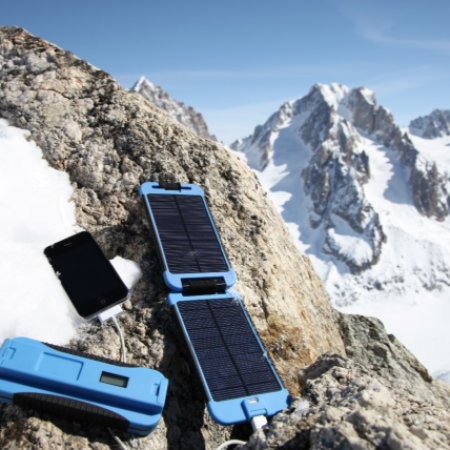Salt Lake City, UT – Like it or not, we’re living in a society that’s powered by batteries. Cameras, GPS units, mobile phones and more all need power. These devices all have a place in the backcountry, but if you’re spending a few days in the middle of nowhere that power is likely to run out before long.
Enter portable power. There are a number of storage batteries and solar chargers on the market designed to accompany you on outdoor endeavors. We had a chance to test products from two of these manufacturers, Powertraveller and Brunton.
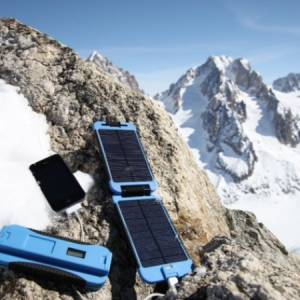
The British company Powertraveller makes a number of portable power solutions that have quickly become our favorites for recharging portable devices in the field when a plug’s not available. Whether skiing from a base camp on a glacier, or trekking across a desert, Powertraveller has an effective modular solution to repower virtually any portable device.
We recently had the chance to test and use a number of the company’s products, including the Powermonkey Extreme ($189.95), the Powergorilla ($239.95) and the Solargorilla ($219.95). All are rugged and durable with rubberized cases for abuse in the field. Each has a specific purpose, some can be used in tandem, and all can help to keep you in communication with the outside world, find your place in it, and record it for posterity.
The Powermonkey Extreme’s waterproof and shock-resistant battery pack holds a whopping 9000 mAh of juice in a compact 242g/8.5 oz. package. It’s maximum rate of 2.1A via a special port is plenty to repower an iPad or other tablet computer, but using dedicated charging tips that the company calls “Monkey Nuts” it’s also equally adept at recharging mobile phones, GPS devices and cameras as many as a dozen times at 700 mA. Both ports can be used at once and an LCD display keeps you informed about what’s going on. It’s paired with a three-watt 214g/7.5 oz. durable folding solar panel to keep the battery pack topped off, or it may be recharged at home from a wall outlet anywhere in the world using the included international adapters. The battery pack’s control switch is touch sensitive and can be easily turned on or off, even with ski gloves on.
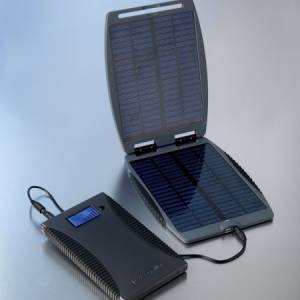
While the solar panel is easily deployed at a base camp, it’s also small enough to conveniently lash to the top lid of a backpack to recharge while on the move. A nifty hard-sided bisected carrying case keeps everything snugly in its proper place, although we preferred that it was a bit less snug to allow more room for Monkey Nuts. Thanks to its versatility, for most uses in the field the Powermonkey Extreme is a compact all-in-one kit for keeping portable devices charged and ready.
If you need even more juice, for powering perhaps a small laptop in base camp, the Powertraveller’s Solargorilla can be used with or without the Powergorilla. As their names imply, these are the company’s big apes. The Solargorilla is a large-sized (820g/29 oz.) version of the solar panel included with the Powermonkey Extreme and has two outputs: a standard 5V USB socket for small devices, and a 20V output that will recharge virtually any laptop.While it’s too large to lash to all but the largest of backpacks, one end of the panel has a slot to attach the Solargorilla to the top of a tent in camp.
The Solargorilla can charge a laptop or portable device directly, but the electricity it generates can also be stored in the Powergorilla. This monster is relatively small in stature (631g/22 oz.) but big on capacity. Its battery delivers a range of 5,500 mAh in 19v mode from its laptop out to 21,000 mAh in 5v mode from USB out, and both can be used to repower both a laptop and a portable device concurrently. It can be expected to provide approximately 2.5 hours of power to a typical laptop. The Powergorilla comes with its own wall charger, but if you use your laptop’s native charger instead to fill the Solargorilla it will automatically adjust its output to the level that your laptop expects, from 8.4v all the way through to 24v. A single button controls the device while a large, easily read LCD display backlit in blue displays output voltage, battery state and more. Its aluminum housing will tolerate ample rough handling.
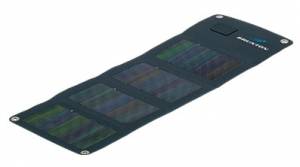
Both the Solargorilla and Powergorilla come with an assortment of Monkey Nuts as well as Gorilla tips for most laptop brands. Each comes with its own lightweight, protective, form-fitting neoprene sleeve. Used alone or in concert, these two devices will provide a portable power solution for many days in the field.
Brunton, another company based in Wyoming, has taken a different approach to solar chargers. Instead of the hard sided cases used by Powertraveller, Brunton has encased the high performance CIGS solar cells in its Solaris 4 USB ($260) in rugged yet pliable rubber to create a four-panel package that puts out 800 mA at 5v, yet weighs only 6.3 oz. and folds down to roughly 9″x7″ while less than a half an inch thick. This allows the Solaris 4 USB to repower any portable device that uses a USB cable to recharge, either directly or by storing the sun’s rays in a battery.
We used the Solaris 4 USB in conjunction with Brunton’s Inspire ($72) on a week-long kayak trip through the Utah desert. The Inspire is a lightweight (5.5 oz.), cost-effective 3200 mAh lithium polymer battery wrapped in a rugged, rubberized plastic case. Output is at a full 1000 mA to recharge energy hungry smartphones via either a USB or miniUSB port. It can be recharged via a computer or a car’s lighter socket, or via a wall outlet with a USB adapter. A series of LEDs display battery and charging status.
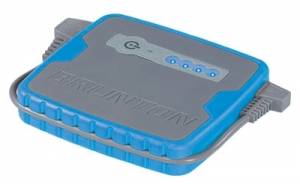
You can of course use the Solaris and the Inspire together, or separately according to your needs. We opted to strap the Solaris 4 USB to the aft deck of our kayak to let it sit in direct sun all day as we paddled, sending the energy to the Inspire stored in our hull. This was an arrangement easily accomplished thanks to the grommets in each corner of the Solaris. At night, long after the sun went down we then connected the Inspire to our GPS unit to have fresh batteries for the next morning. It worked like a charm and kept us on course for the entire week. It would easily serve the same function at a backcountry skiing base camp.

